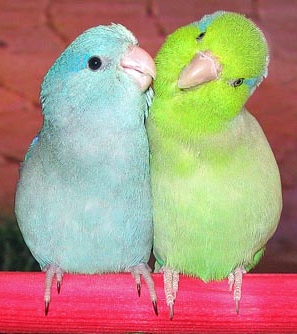
Pacific parrotlets were our featured Animal of the Month for September, but now these tiny little bundles of energy are flying out of the spotlight as the month draws to a close. We tweeted all month about these sassy birds @ExoticPetVets. But if you missed any of our tweets, here’s a summary. Did you know?:
- The Pacific parrotlet (Forpus coelestis) is native to Ecaudor and Peru.
- Other names for Pacific parrotlets include Lesson’s parrotlets & pocket parrotlets because they can fit in your pocket.
- The Pacific parrotlet is also known as the celestial parrotlet.
- The “coelestis” part of the Pacific parrotlet’s scientific name means “heavenly” in Latin.
- Pacific parrotlets are small, measuring between 3 – 5.5 inches (7 – 13 cms) in length and weighing between 24 – 32 grams.
- Don’t let their size fool you. Pacific parrotlets have big personalities and can be aggressive towards much larger birds.
- Pacific parrotlets are known to be fearless.
- Pacific parrotlets have stout bodies and short tails. Their natural colours are grey and olive feathers with a green face.
- Male Pacific parrotlets have blue feathers behind their eyes. Most females lack these, but some have faint blue streaks.
- Selective breeding has created many different colours of Pacific parrotlets, including green, blue and lutino.
- In captivity, Pacific parrotlets do well on their own but they can enjoy being with another Pacific parrotlet in a pair.
- Because they’re feisty, Pacific parrotlets in captivity should be kept away from other species of birds to avoid fights.
- Pacific parrotlets in captivity should be properly socialized from a young age or they can become unruly.
- Pacific parrotlets aren’t noisy birds. They don’t squawk and their chirping is fairly low volume compared to other birds.
- Because they aren’t noisy Pacific parrotlets can be good companions for apartment dwellers. They won’t bug the neighbours.
- They’re parrots, but Pacific parrotlets aren’t great talkers. But they can learn to say some simple words and phrases.
- Pacific parrotlets are tiny bundles of engery. In the wild, they fly, forage and dodge predators every day.
- In captivity, Pacific parrotlets are just as active as they are in the wild. They love play time with their families.
- Pacific parrotlets in captivity are also very affectionate with their families and will sit in your shirt pocket.
- Pacific parrotlets in captivity need bird-safe toys to play with to prevent boredom.
- Because of their high energy, Pacific parrotlets in captivity may need more food compared to other birds their size.
- With proper care, Pacific parrotlets in captivity can live an average of 12-15 years, but some reports have them living as long as 30.

